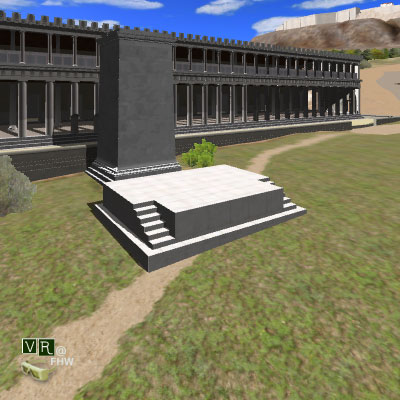Location: : In front of the façade of the Stoa of Attalus (no. 22 in the Agora plan of the Guide: Mc CAMP II, J., The Athenian Agora: A Short Guide to the Excavations, Excavations of the Athenian Agora, Picture Book no 16, American School of Classical Studies, Princeton 2003, pp. 2 and 24-25), roughly in the middle of the eastern side, and in front of the honorary pedestal.
Date of Construction: 2nd cent. BC. (?) It is destroyed in 267 AD (?)
Periods of use: Hellenistic, Roman.
INTRODUCTION
This rectangular Hellenistic monument, erected in front of the Stoa of Attalus is identified with the rostrum from which in 88 BC the philosopher Athenion called upon the Athenians to side against Rome in the first Mithridatic War. Save its foundations, no other part of the rostrum survives today.
HELLENISTIC PERIOD
The excavators of the Agora identify the rectangular foundations east of Attalus’ Stoa and in front of the honorary pedestal, excavated in 1937, as the rostrum which is related to a dramatic turning point in the history of Ancient Athens. The rostrum, as we learn from Athenaeus (5, 212e ff.) was erected so that the Roman generals could address the Athenian people in the area of the Agora (undoubtedly a Roman habit, which equated the Greek marketplace to the Roman Forum). In 88 BC, and as the 1st Mithridatic War, which led to the slaughter of 80,000 Italians, was raging in Asia Minor, the Peripatetic philosopher and orator Athenion, a supporter of the designs of Mithridates VI of Pontus, mounted the rostrum and addressed the multitude that had swarmed to the Agora, Athenians as well as foreigners. He urged them to not tolerate any further the anarchy caused by Roman rule, which brought about the abandonment of their traditional ways and were responsible for the desolation reigning in the Ecclesia of the Demos. Following a debate, the throng moved to the theatre (where since the 4th century already the Ecclesia of the Demos convened) and elected Athenion a general. Athens fought on the side of Mithridates, and the city was laid to siege, captured and ravaged by Sulla in 86, although he did not raise it to the ground. Out of respect for the Athenians’ ancient greatness the Romans refrained from whipping their city off the map.
The foundation of the monument measured 5.6 Χ 8.35 m. On either side, on the NW and the SW corner, we should suppose the existence of stairs affording access to the top of the rostrum. The quality of the stonework and the stalwartness of the foundations allow us to conclude that it was a solid and permanent construction. The concentration of a number of pedestals and various other types of monuments in this area suggests that it was one of the most frequented spots of the Agora during the Hellenistic period.
The erection of the rostrum must be dated somewhere between 150, when the Stoa of Attalus was built and 88 BC. The term “Roman Generals” may be a reference to the governors of the province of Achaea, its construction might therefore be placed after 146 BC. No recognizable part of the superstructure remains, nor is it clear when it was destroyed. Possibly, it was used as quarry for building material after the destruction of the Stoa of Attalus and the nearby monuments by the Heruli in 267 BC.
BIBLIOGRAPHY
Mc CAMP II, J.,
The Athenian Agora: A Guide to the Excavation and Museum, 4th ed., Athens 1990, pp.127-130.
Shear, T.L., “The Campaign of 1937”,
Hesperia 7 (1938), p. 324.
THOMPSON, H.A., WYCHERLEY, R.,
The Agora of Athens. The American Excavations in the Athenian Agora, vol. XIV, American School of Classical Studies at Athens, Princeton 1972, pp. 51 and 220, n. 3.
WYCHERLEY, R.,
The Agora of Athens. Literary and Epigraphic Testimonia, The American Excavations in the Athenian Agora, vol. XIV, American School of Classical Studies at Athens, Princeton 1957, no. 99.

Representation in VR environment

